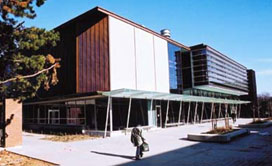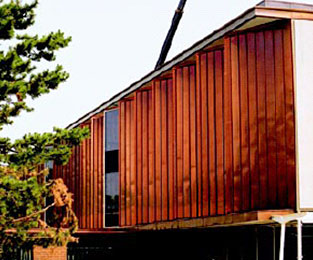Completed in 2001, the Computer Science and Engineering Building at York University in Toronto exemplifies a number of the benefits associated with both green building design and the use of copper. The building, which occupies a central location on the campus, has been recognized by its users and by numerous international awards for its innovative design. Its copper façade provides a visually stunning external skin to a building that has been exceptionally well-planned throughout, minimizing its impact and leveraging the natural benefits of its location.
The Building
Overview

The Computer Science and Engineering Building’s envelope provides a diverse, engaging experience for passing students
Photo: www.copper.ca
The four-story building brings together three main elements: a 950-seat lecture hall, large atria and office and lecture spaces. Located on the main pedestrian thoroughfare, the building’s extensive glazing and airy entry engage pedestrians, a feature important to the University. Large copper pans without transverse seams dominate the façade covering the upper two stories. The effect is visually stunning and integrates well with the nearby buildings, which contain numerous copper accents. Glazing used extensively both inside and out creates an open and inviting building.
What Makes It Green?
Genesis phase
The overall design ensures the functions of each building element do not overlap and are mutually supportive, making the total building superior to its individual parts.1 Both the designers and York University committed early in the project to select materials and designs which met the objectives of a green building.
The Strategy
Originally the location was to house the Department of Environmental Science, which introduced the concept of green building to the university’s decision makers. This was coupled with a concern for sustainability and an appreciation of the benefits of the design, such as daylighting and lower operational costs.
Climate Control
A major challenge for the designers was to apply strategies, learned and tested in moderate West Coast climates, to the highly variable climate of Southern Ontario where temperatures commonly vary between –13°F (-25°C) and 85°F (30°C) throughout the year. Not surprisingly one of the centerpieces of the building is the air-circulation and temperature-moderating system.
Lighting
Daylight is an important feature of the building. Every space has access to natural light, either through direct external access or through one of the atria. This helps minimize the heat generated and energy used by lighting while improving the occupant’s enjoyment of the building. Building electricity usage records show that, on sunny days, occupants choose not to turn their lights on.

Natural ventilation, incorporating a central atrium, thermal “chimneys” and openable windows minimize energy demands
Photo: www.greenbuilding.ca
Material Selection
The designers did a great deal of research to select materials with low environmental life-cycle impacts and to avoid excessive material use. Their focus on the environmental performance of materials led to the use of copper in applications throughout the project.
Copper's Role
Copper is used extensively on the outside of the building with two-story-high pans that eliminate the need for transverse seams all along the sawtooth features on the east and west sides of the building, as well as along all the soffits. Copper was chosen for a number of reasons, including its durability, low cost of maintenance, coloring, low embodied energy (measured by the project engineers) and recyclability. As it turns out, the copper cladding provides unexpected operational benefits as well.
Heat Capture
The ability of the copper cladding to capture the heat of the sun in winter came as a pleasant surprise to the building’s operators. Based on what they learned, designers of the building have exploited this solar wall strategy in subsequent projects.
Cost Savings

Large pans provide a stunning feature to the west and east sides of the York University building
Photo: www.copper.ca
The use of copper on the façade contributes substantially to minimizing the expected maintenance requirements and the operating costs of the building. The designers selected copper instead of their original material choice for the soffits, because the longterm cost savings more than offset a slightly higher initial cost. Beyond the financial rewards, environmental benefits include eliminating the need for coatings or finishes.
Aesthetics
Copper is easy to manipulate and install. That allowed the designers to create the striking effect of the large pans. Copper was chosen for the prominent façades, and, with the development of the pans’ patina, the building will have an evolving and “noble” color. Also, the nearby Stacy Science Library has a number of copper elements, including light fixtures and flashings. Using copper on the new building was an opportunity to maintain consistency.
Embodied Energy
An important criterion that led to the selection of copper was its low level of embodied energy. Copper is highly recyclable and durable and retains between 90% and 95% of its value relative to the cost of new copper.2 As a result, the majority of copper ever extracted is still in circulation today. Also, the York project sourced and formed the copper locally. This was another benefit that reduced energy across the life cycle and prompted the use of copper. Finally, the designers are confident that, when the building reaches its end of life, the copper can easily be reused in other applications, further improving the building’s longterm environmental performance.
Expertise provided by Heather & Little Ltd. (fabricators) and the French Bothers Roofing & Sheet Metal (installation) helped the designers to achieve their vision and ensure that the copper worked seamlessly with the other elements of the building.
Conclusion
The design choices for York University’s Computer Sciences Building, from the selection of materials to minimize its environmental footprint and operational costs through to its user friendly design, resulted in a highly attractive and highly efficient building. It’s received numerous awards, including the 2002 “Green Building of the Year” from World Architecture Magazine.
The building’s operation exceeds the ASHRE 90.1 standard by 50%. And every year the building’s operating costs have declined, as the building “teaches” its users how to leverage its features to maximize its efficiency. Further, the designers spent only 15% of the building’s budget on its mechanical systems, rather than the conventional 30%.
Since this project, York University has incorporated sustainability criteria into a number of its new projects. This, more than any other fact, demonstrates the success of this experiment in cold weather green building.
